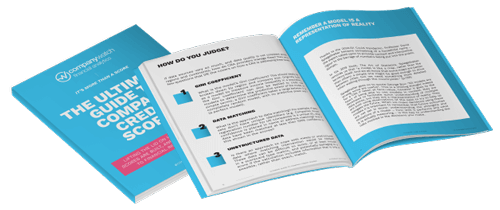Top 4 Warning Signs in a Company Credit Report That Most Businesses Miss

A thorough company credit report is an essential step in any prudent credit risk assessment. Yet even seasoned risk managers sometimes overlook subtle clues buried in a business credit report.
We know that businesses that end up with bad debt are 3x more likely to fail within 12 months, and nearly 43% of businesses cite late payments as their biggest cash flow challenge.
In other words, if a customer or supplier suddenly goes under, the ripple effect can hurt your own cash flow and stability. Knowing how to read a company credit report beyond the headline credit score is critical to protect your business.
In this post, we’ll explore five warning signs in a company credit report that most businesses miss. Paying attention to these red flags can make the difference between a smooth partnership and a costly insolvency. Let’s dive in.
1. Habitual late Payments and legal judgments
One easily overlooked warning sign is a pattern of late payments or legal actions against the company. It’s not enough to note that a firm eventually pays its bills; the key is how and when they pay.
A history of consistently late invoice payments or any County Court Judgments (CCJs) on record should set off alarms. CCJs are court orders for unpaid debts, and they frequently serve as a precursor to more severe legal proceedings.
In fact, multiple unsatisfied (unpaid) CCJs are widely recognised as a key indicator of financial distress. According to legal experts, if a company has a growing number of unsatisfied judgments, it strongly suggests they’re struggling to pay creditors on time, a classic sign of a cash-flow crisis.
When conducting a company credit check, dig into the payment history section of the business credit report. Look for any mention of court filings, debt collection actions, or chronically slow payment of suppliers. Many businesses make the mistake of focusing only on the credit score and missing these telltale signs. But a company with even a single recent CCJ or numerous late payment notices could be one step away from insolvency.
If you spot such red flags in the credit report, proceed with caution or consider tighter payment terms. It’s far better to flag a risky partner early than to find out later when they can’t pay what they owe.
2. Sudden drop in credit score or financial health
Another warning sign that often flies under the radar is a significant decline in the company’s credit score or financial health metrics. Most people check a partner’s credit rating once and assume all is well if it’s above a certain threshold. However, it’s critical to examine the trend of that score over time.
A sudden drop in a business’s credit score – or a downward trend over several reporting periods – can signal that something is fundamentally wrong. A sudden drop in credit score could indicate deteriorating financial health, such as falling revenue, rising debt, or new legal problems. In short, don’t just look at where the score is now; look at where it’s heading.
For a true company financial health check, you may need to go beyond standard credit scores. Company Watch’s proprietary H-Score® rates a company’s financial health on a 0–100 scale, with anything 25 or below falling into a high-risk “Warning Area”. If you see a company’s score sliding toward that danger zone, take note. Even if the current rating is acceptable, a sharp decline (or a low financial health score relative to peers) is one of those red flags most businesses miss until it’s too late.
To stay ahead, Forecast View™ by Company Watch lets you stress test companies against potential future risks, helping you model how changing economic conditions could impact financial health before problems arise.
3. Overleveraging and cash-flow strain
Debt can fuel growth, but too much of it? That’s a red flag many miss. If a business is using most of its available credit (known as high credit utilisation), or has taken on multiple new loans in a short time, it might be borrowing just to stay afloat. That’s a classic sign of financial distress.
As a rule of thumb, credit utilisation over 50% means the company could be overextended and vulnerable to downturns. You’ll often spot this in the financial ratios or credit limits section of a business credit report.
Worryingly, about 16% of mid-sized UK businesses are now what analysts call “Zombie companies” i.e. firms only earning enough to cover interest payments, with no real profit or growth. If revenues dip or rates rise, these businesses can go under fast. Especially dangerous if they’re a key supplier or customer.
Bottom line? Don’t be distracted by surface-level figures. If debt is rising and cash flow’s tight, you could be looking at trouble ahead. That’s why a smart credit risk assessment always looks deeper.
4. Management turmoil and opaque filings
Financial numbers alone don’t tell the whole story. Often, the qualitative aspects of a company’s record can reveal risks that a balance sheet won’t. Frequent management turnover, opaque filings, or inconsistent information are all warning signs that are easy to miss.
For instance, if you discover that multiple directors have recently resigned from the company, ask yourself why. Multiple director resignations in a short time can indicate internal turmoil. Sometimes executives jump ship to avoid being associated with a failing company. A company’s stability is closely tied to its leadership. A revolving door in the boardroom is rarely a good sign for financial health.
Similarly, pay attention to the company’s filing history with Companies House. Late filing or non-filing of annual accounts is a glaring red flag. While not every late filing is due to trouble, a common reason for tardy accounts is that the company lacks the funds or reliable financial records to prepare them.
Running a company without up-to-date accounts is like “driving a car with your eyes closed”. If a company credit report notes that accounts are overdue or there are qualified audit opinions, do not brush that aside.
Vigilance™ by Company Watch scans for these anomalies. It can flag behaviour such as a company exceeding VAT tax thresholds without being VAT-registered, which could indicate tax evasion or negligent management. These are the kinds of details a casual glance won’t catch.
It’s wise to perform a quick director search on key principals as well. If a director has a history of multiple insolvencies or disqualifications, that dramatically raises the risk profile of the company. Company Watch’s Director Search feature can quickly reveal if a director is linked to any past failed businesses or has been disqualified from acting as a director.
Stay ahead of financial risk
A company credit check is only as good as the red flags you’re able to spot and act upon. By looking beyond the surface and watching for these four warning signs, you can dramatically improve your credit risk assessment process.
The goal is to be proactive. Identify the subtle supplier credit risk indicators or customer instability before they escalate into defaults or insolvencies that impact your business.

